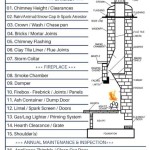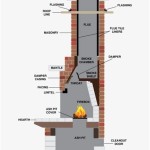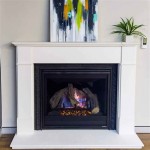Fireplace Interior Design: A Comprehensive Overview
Fireplaces have long been a focal point in interior design, serving as both a functional source of heat and an aesthetic centerpiece. Their presence can significantly impact the ambiance and overall style of a room. Designing a fireplace effectively requires careful consideration of various elements, including architectural style, material selection, spatial context, and functionality. This article provides a comprehensive overview of fireplace interior design, exploring key considerations and design principles that contribute to creating a visually appealing and practical fireplace feature.
Understanding Architectural Styles and Fireplace Design
The architectural style of a building plays a crucial role in determining the appropriate design for a fireplace. A fireplace should complement the existing architectural features and contribute to the overall aesthetic coherence of the space. Understanding the nuances of different styles is essential for achieving a harmonious and visually pleasing outcome.
For instance, traditional architectural styles, such as Georgian or Victorian, often feature fireplaces with ornate details, including elaborate mantels, decorative moldings, and intricate carvings. These fireplaces typically incorporate materials such as marble, stone, or wood, and are designed to exude a sense of grandeur and formality. The scale and proportions of the fireplace are also carefully considered to align with the overall architectural scale of the room.
In contrast, modern and contemporary architectural styles typically favor minimalist and streamlined fireplace designs. These fireplaces often feature clean lines, simple shapes, and a focus on functionality. Materials commonly used in modern fireplaces include concrete, steel, glass, and tile. The emphasis is on creating a sleek and uncluttered aesthetic that complements the minimalist sensibilities of the space. Fireplace surrounds may be integrated seamlessly into the wall or designed as a standalone feature, depending on the overall design intent.
Rustic and farmhouse architectural styles often incorporate fireplaces with a more natural and informal aesthetic. These fireplaces typically feature materials such as natural stone, brick, or reclaimed wood. The design may include exposed beams, rough textures, and a focus on creating a cozy and inviting atmosphere. Fireplace surrounds may be larger in scale to accommodate wood storage or decorative elements that enhance the rustic charm of the space.
Ultimately, the architectural style serves as a guiding framework for making design decisions related to the fireplace. It is crucial to carefully consider the existing architectural features and select a fireplace design that complements and enhances the overall aesthetic of the building.
Material Selection and its Impact on Fireplace Design
The materials used in fireplace construction and design significantly influence its aesthetic appeal and functionality. The selection of appropriate materials requires careful consideration of factors such as durability, heat resistance, maintenance requirements, and overall aesthetic compatibility with the surrounding space.
Stone is a popular choice for fireplace surrounds due to its natural beauty, durability, and heat resistance. Various types of stone, such as marble, granite, limestone, and slate, offer a wide range of colors, textures, and patterns, allowing for diverse design possibilities. Stone fireplaces can be designed to complement both traditional and contemporary architectural styles, depending on the type of stone selected and the overall design approach.
Brick is another commonly used material for fireplace construction, particularly in traditional and rustic settings. Brick offers a warm and inviting aesthetic, and its inherent texture adds visual interest to the fireplace surround. Brick fireplaces can be painted, stained, or left in their natural state, depending on the desired aesthetic. The use of different brick patterns, such as herringbone or stacked bond, can further enhance the visual appeal of the fireplace.
Wood is often used for fireplace mantels and decorative elements, adding a touch of warmth and elegance to the design. Various types of wood, such as oak, maple, cherry, and walnut, offer different colors and grains, allowing for customization based on the overall design scheme. Wood mantels can be stained, painted, or left in their natural state to showcase the beauty of the wood grain. It is important to select wood that is suitable for use near heat sources and to ensure proper ventilation to prevent overheating.
Concrete is a versatile material that is increasingly used in modern and contemporary fireplace designs. Concrete fireplaces can be cast in various shapes and sizes, allowing for seamless integration into the wall or the creation of freestanding sculptural elements. Concrete can be stained, polished, or left in its natural state, offering a range of aesthetic possibilities. Its durability and heat resistance make it a suitable material for fireplace surrounds and hearths.
Metal, such as steel or stainless steel, can also be incorporated into fireplace designs, particularly in modern and industrial settings. Metal fireplace surrounds can be sleek and minimalist, adding a touch of sophistication to the space. Metal can be used for framing, detailing, or as a contrasting element against other materials. Its durability and heat resistance make it a practical choice for fireplace construction.
The selection of appropriate materials is essential for creating a fireplace that is both visually appealing and functionally sound. Careful consideration of factors such as durability, heat resistance, maintenance requirements, and aesthetic compatibility with the surrounding space will contribute to a successful outcome.
Spatial Considerations and Fireplace Placement
The placement of a fireplace within a room significantly impacts its functionality and visual impact. Careful consideration of spatial considerations, such as room size, layout, and sightlines, is essential for optimizing the fireplace's presence and creating a balanced and harmonious interior.
In a living room, the fireplace is often positioned as a focal point, drawing attention and anchoring the seating arrangement. It is commonly placed on a central wall, providing a visual anchor for the room and creating a natural gathering space. The seating arrangement is typically oriented towards the fireplace, encouraging conversation and creating a cozy atmosphere. The proximity of furniture to the fireplace should be carefully considered to ensure safety and comfort.
In a bedroom, a fireplace can create a warm and inviting ambiance, adding a touch of luxury and relaxation. The fireplace is often positioned on a wall opposite the bed, providing a visual focal point and creating a sense of balance. The scale and proportions of the fireplace should be carefully considered to ensure that it does not overwhelm the space. A smaller fireplace may be more appropriate for a smaller bedroom, while a larger fireplace may be suitable for a more spacious bedroom.
In an open-plan living space, the fireplace can serve as a visual divider, delineating different areas of the room. The fireplace can be positioned as a freestanding element, separating the living area from the dining area or kitchen. This can create a sense of definition and privacy while maintaining a sense of openness and connectivity. The design of the fireplace should be carefully considered to ensure that it complements the overall design scheme of the open-plan space.
The dimensions of the fireplace should be carefully considered in relation to the size of the room. A fireplace that is too large can overwhelm the space, while a fireplace that is too small may be visually insignificant. The height of the fireplace mantel should also be carefully considered to ensure that it is proportionate to the overall height of the room. A mantel that is too high may appear awkward, while a mantel that is too low may lack visual impact.
Proper ventilation is an essential consideration when placing a fireplace. The fireplace should be located in an area where it can be properly vented to the outside, ensuring that smoke and gases are safely exhausted. The placement of the fireplace should also take into account the proximity of windows and doors, as drafts can affect the efficiency of the fireplace and potentially cause smoke to back up into the room.
Careful consideration of spatial considerations is essential for optimizing the fireplace's functionality and visual impact. The placement of the fireplace should be carefully planned to create a balanced and harmonious interior that enhances the overall ambiance of the space.
Functionality and Safety Considerations
Beyond aesthetics, the functionality and safety of a fireplace are paramount. A well-designed fireplace should provide efficient heating while adhering to safety standards to prevent accidents and ensure the well-being of occupants.
Proper ventilation is crucial for ensuring the safe operation of a fireplace. The chimney should be properly sized and constructed to effectively exhaust smoke and gases from the fireplace. Regular chimney inspections and cleaning are essential to prevent buildup of creosote, a highly flammable substance that can lead to chimney fires. The damper should be in good working order to prevent drafts and allow for proper airflow during combustion.
The hearth, the non-combustible area surrounding the fireplace opening, plays a crucial role in preventing fires from spreading to combustible materials. The hearth should be made of fire-resistant materials such as stone, brick, or tile, and should extend a sufficient distance in front of the fireplace opening to catch embers and sparks. The size and shape of the hearth should be appropriate for the size of the fireplace opening and the type of fuel being burned.
The distance between the fireplace opening and combustible materials, such as furniture, curtains, and woodwork, should be carefully considered to prevent overheating and potential fires. Building codes typically specify minimum clearances between the fireplace and combustible materials. These clearances should be strictly adhered to ensure the safety of the occupants. Heat shields can be used to further reduce the risk of overheating combustible materials.
The type of fuel used in the fireplace should be appropriate for the design and construction of the fireplace. Wood-burning fireplaces should only burn seasoned hardwood, as softwoods and unseasoned wood can produce excessive smoke and creosote. Gas fireplaces should be properly connected to a gas line and should be inspected regularly for leaks. Electric fireplaces do not require ventilation or fuel, but they should be used in accordance with the manufacturer's instructions.
The use of a fireplace screen or glass doors can help to contain sparks and embers, preventing them from escaping the fireplace and potentially causing fires. Fireplace screens should be made of a durable, non-combustible material and should fit snugly against the fireplace opening. Glass doors can also help to improve the efficiency of the fireplace by reducing drafts and preventing heat loss.
Smoke detectors and carbon monoxide detectors should be installed in the vicinity of the fireplace to provide early warning of potential hazards. Smoke detectors should be located on each level of the home, including near sleeping areas. Carbon monoxide detectors should be located near fuel-burning appliances, such as fireplaces and furnaces. Regular testing and maintenance of these detectors are essential for ensuring their proper function.
Prioritizing functionality and safety when designing a fireplace is crucial for protecting occupants and preventing accidents. Adhering to building codes, implementing proper ventilation measures, and using appropriate materials and safety equipment will contribute to a safe and enjoyable fireplace experience.

5 Ways A Fireplace Can Benefit Your Interior Design Fiveways Fires Stoves

Fireplace Interior Design Inspiration From 7 Influencers

36 Fireplace Decor Ideas Modern Mantel

40 Fabulous Fireplace Design Ideas For Any Budget Or Style

Fireplaces Jane Lockhart Design

8 Cozy Fireplace Designs I M Loving K Peterson Design

Fireplace Designs Interior Design Berkshire Falchi Interiors

Fireplaces Jane Lockhart Design

How To Make Your Fireplace Renovation Look Like A Studio Mcgee Project Courtney Turk Interiors Interior Decorator Design Services

40 Best Fireplace Décor Ideas Mantel








